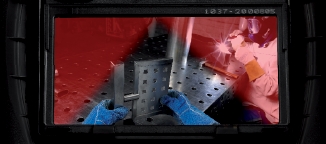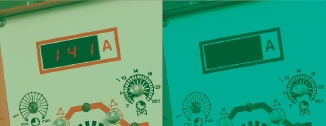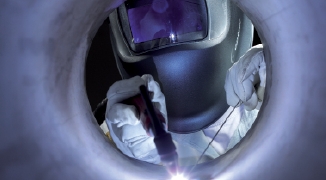

ADF – Auto Darkening Filter The ADF, or automatic darkening filter, consists of liquid crystal displays (LCDs), electronic components, solar cells/batteries, sensors and a UV/IR filter. This is the part of the helmet that automatically darkens when a welding arc is struck. optrel provides a wide range of ADFs with various features and shade protection options. During certification, the quality of an ADF is assessed in line with the European standard. The following four criteria are graded in order to provide the welder with an indication of quality: optical class, scattered light, homogeneity and dependence on angle of vision. All ratings must be stated on the darkening filter: 1 is the highest rating and 3 the lowest. |
Solar cells & batteries The power needed to operate the ADF can be guaranteed over different types of power supply. For all expert- and pro-helmets, the power during welding comes from the solar cells, which generate energy out of the welding arc. However, to start the welding helmet the first time for each welding session, a back up battery is also included. For all optrel helmets, there is no need to switch it on or off. |
|
LCD - Liquid Crystal Display LCDs form part of the ADF. Amongst other things they contain liquid crystals which allow for automatic darkening of the filter. The arrangement of the liquid crystals is controlled by electric pulses. Different arrangements allow the liquid crystals to respond in different ways to the light intensity. |
Front cover lens The front cover lens is fitted on the helmet in front of the darkening filter. It prevents weld spatter from reaching and damaging the darkening filter. The front cover lens has to be replaced regularly depending on the welding process and dirt levels experienced. |
|
UV/IR filter A filter is used to reliably reflect optical radiation in the UV and IR range. The filter is permanently fitted in the ADF and offers permanent protection regardless of whether the darkening filter is in the dark or light state. |
Inside cover lens An inside cover lens is used to protect the back of the ADF from dust and other dirt. This thin plastic lens is a wearing part and canbe replaced when it becomes dirty and discoloured. |
|
Sensors The sensors fitted in the ADF detect when an arc is struck. When this happens, the sensors transmit a signal to the electronics which then activate the LCDs. |
Sensor bar / slide We all know what it feels like when the sensor detection angle causes an automatic helmet to respond to the arc of a neighbouring welder. optrel has the perfect solution. Its patented sensor slide allows the detection angle to be reduced from 120° to 60° to prevent the ADF from responding to welding nearby. |
 |
|||
Seeing true colours Specially coated filters which enable the welding object to be viewed better are used in selected expert products. This kind of filter optimises colour detection such that the welder is able to view colours in the surrounding area in an almost true form. This allows the welder to easily read red LEDs on the welding device without having to raise his helmet, thereby improving efficiency and safety. |
 ; ; |
|||
Sensitivity function If several welders are working in a room or in close proximity to one another, sometimes the ADF responds too soon or not at all to the flash because the preset sensor sensitivity is not right for the working environment conditions. Continuously variable sensitivity control allows the sensor sensitivity to be adapted to the surroundings and workplace. This function can also be used if welding at low amperages and the ADF is not therefore darkening. |
 |
|||
Delay function/opening delay We all know how uncomfortable your eyes are when a material continues to glow after welding. If the helmet quickly switches from dark to light after a long period of welding, the welder can be briefly dazzled. The welder can use the delay function to delay the ADF from opening, thereby greatly improving operating comfort. |
Slow | |||
 |
 |
 |
||
| 0,2 sec. | 0,3 sec. | 0,6 sec. | ||
 |
 |
 |
||
| Fast | ||||
Shade level The shade level specifies how much the ADF darkens. A shade level is selected according to the welding process and amperage. The shade level also depends on the welder's eyes and age. optrel is the first manufacturer anywhere in the world to offer a product which can automatically detect the shade level required (see page 15). This function translates into a real efficiency gain when welding at alternating power intensities. |
 |
 |
 |
|
| Shade level 4 |
Shade level 9 |
Shade level 13 |
||
Grinding mode If a helmet has this function, it means that the ADF can be fixed in the light state for the duration of the grinding process. This prevents the filter from darkening due to flashes when grinding. |
 |
|||